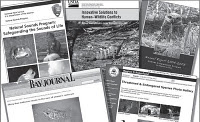
The
NBII Library of Images From the Environment (NBII LIFE) is a collaborative platform for agencies, organizations, and individual partners to share high quality, authoritative images of our natural world. Subjects cover species, species interactions, landscapes, research, management, and environmental topics. The goal is to manage images as scientific records and ensure they are useful for future research and decision making.
Contributors and images must meet certain criteria, including that

the images are available for nonprofit use and that detailed information (e.g., date, location, and context) is attached.
These standards and subject diversity make
LIFE a valuable resource – as research and user feedback have confirmed. One type of user we get feedback from are those who contribute images to
LIFE; examples include Finding Species, different groups within the
U.S. Geological Survey (USGS), and the
U.S. National Herbarium,
Smithsonian Institution. But who in the broader community is accessing the site, and how do they use the images?

There are limits to what the U.S. government can record about users accessing government Web sites, but we know hundreds of thousands of people viewed millions of pages within the
NBII LIFE in 2009, most from U.S. government computers. Globally, an average of 150 countries (out of 203 recorded) also had users entering the library each month. Leading countries include Canada, Great Britain, and India; but small countries such as Liechtenstein and Vatican City also accessed the
NBII LIFE Web site.
Many organizations point to the
NBII LIFE as a resource, including the
U.S. Bureau of Land Management. Other federal sites include the
USGS, the
U.S. Fish and Wildlife Service (USFWS), and the
Library of Congress. The
Academy of Natural Sciences’
Vireo Web site includes the LIFE under “
Sites Worth Seeing” and
Matcha College lists LIFE in an article, “
100 Excellent Websites for Exploring the Ocean Online”.
LIFE is also finding that diverse organizations are using

photographs for exhibits, Web sites, publications, and research, including federal agencies such as the
USGS (the biggest user), the
USFWS, the
U.S. Environmental Protection Agency (EPA), the
National Institute of Health, the
National Aeronautics and Space Administration, the
U.S. Department of Agriculture (USDA), and the
Smithsonian Institution. Local and state agencies (e.g., New York State’s
Department of Environmental Conservation) and nonprofits (e.g., the
Defenders of Wildlife) have also used LIFE's images. One research project incorporating LIFE images is the
Tree of Life project.

News and information organizations also have used
NBII LIFE images to illustrate online articles, including
Public Radio International,
Encyclopedia Britannica,
Wikipedia, the
Washington Post, and
Science magazine. Also, hundreds of educational sites incorporate LIFE images into their lesson plans: students have used images for book reports and in computer modeling classes. Other users include libraries, museums, botanical gardens, film makers, artists, and bloggers. Users’ interests have been very diverse.
The NBII LIFE's images may soon be used in additional ways.

The LIFE team is partnering with the
Global Biodiversity Information Facility to make image metadata available to more researchers, especially modelers. Metadata about a photograph of a rare bird at a certain place and time could be fed into models predicting the effects of climate change on species distributions. Schema development is under way.
The LIFE team looks forward to increased use and further feedback, with the Web site’s latest tools online, continuing image uploads, and a new strategic plan to increase capabilities.
Photos from the NBII LIFE: (from top) Cactus (Sempervivum sp., Echeveria sp.) Cactus rosettes fill a garden bed. Photo by © 2008 Elizabeth A. Sellers; U.S. Geological Survey (USGS) hydrologist making a mini-piezometer measurement on the Yakima River to determine if ground-water discharge is occurring in this salmon rearing area. Photo by W. Simmonds; American bullfrog floats among lily pads (Rana catesbeiana). Photo by © 2008 Bruce Avera Hunter (Copyright held by Creator); Blue Ridge Parkway with fall foliage. Photo by Tanya Schoenhoff; Print and online publications using NBII LIFE images; A male scarlet tanager (Piranga olivacea) ready to be released after receiving a metal leg band applied by a wildlife biologist. Photo by © 2009 Elizabeth A. Sellers.
This is a revised version of the article published in the Winter 2010 (Vol. 13, No. 1) issue of the NBII Access Newsletter.
 Thumbnails of LIFE's 28,000 scientific images are available through Science.gov, with direct links back to the LIFE Web site for detailed information and original image sizes. The debut of Science.gov's image search is being featured in online news and blog sites such as Information Today, Knowledge Speak, the Intellogist Blog, the Special Libraries Association, LibraryJournal.com, the NASA wiki, and others. LIFE will soon upload an additional 30,000 images contributed by the USGS and partner agencies to its Web site; those images will also be available to Science.gov's search tool.
Thumbnails of LIFE's 28,000 scientific images are available through Science.gov, with direct links back to the LIFE Web site for detailed information and original image sizes. The debut of Science.gov's image search is being featured in online news and blog sites such as Information Today, Knowledge Speak, the Intellogist Blog, the Special Libraries Association, LibraryJournal.com, the NASA wiki, and others. LIFE will soon upload an additional 30,000 images contributed by the USGS and partner agencies to its Web site; those images will also be available to Science.gov's search tool.







